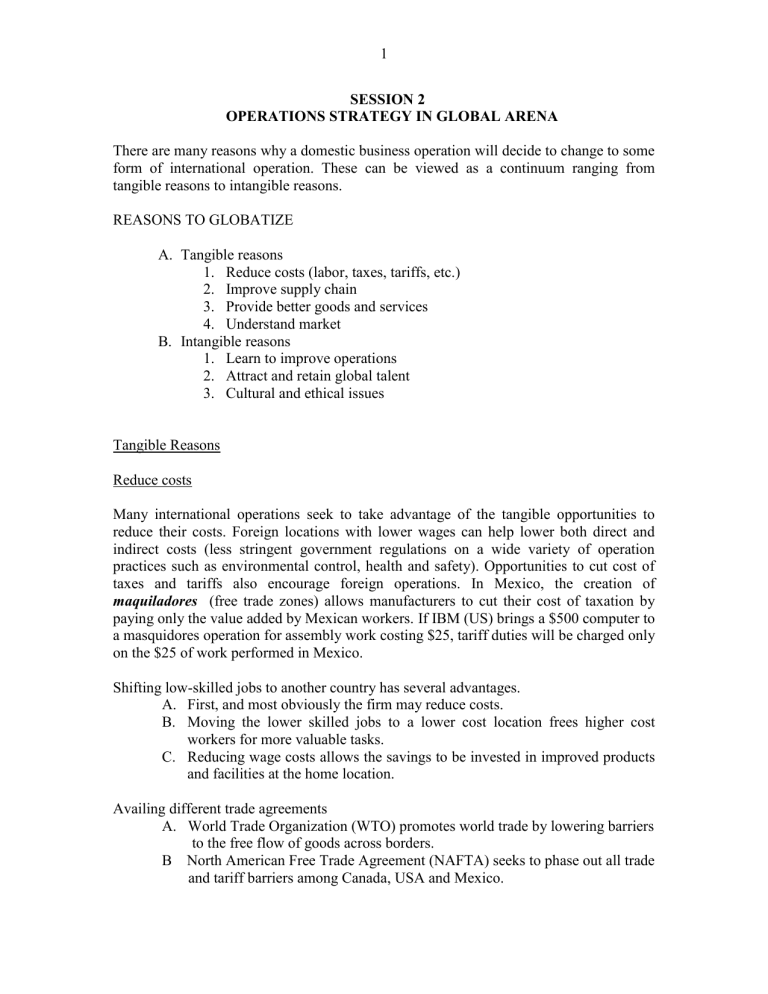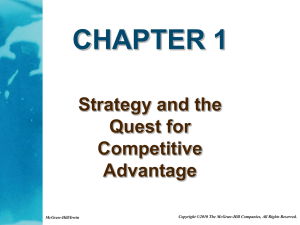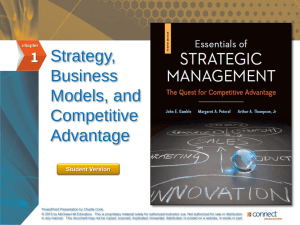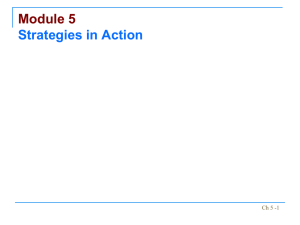
1 SESSION 2 OPERATIONS STRATEGY IN GLOBAL ARENA There are many reasons why a domestic business operation will decide to change to some form of international operation. These can be viewed as a continuum ranging from tangible reasons to intangible reasons. REASONS TO GLOBATIZE A. Tangible reasons 1. Reduce costs (labor, taxes, tariffs, etc.) 2. Improve supply chain 3. Provide better goods and services 4. Understand market B. Intangible reasons 1. Learn to improve operations 2. Attract and retain global talent 3. Cultural and ethical issues Tangible Reasons Reduce costs Many international operations seek to take advantage of the tangible opportunities to reduce their costs. Foreign locations with lower wages can help lower both direct and indirect costs (less stringent government regulations on a wide variety of operation practices such as environmental control, health and safety). Opportunities to cut cost of taxes and tariffs also encourage foreign operations. In Mexico, the creation of maquiladores (free trade zones) allows manufacturers to cut their cost of taxation by paying only the value added by Mexican workers. If IBM (US) brings a $500 computer to a masquidores operation for assembly work costing $25, tariff duties will be charged only on the $25 of work performed in Mexico. Shifting low-skilled jobs to another country has several advantages. A. First, and most obviously the firm may reduce costs. B. Moving the lower skilled jobs to a lower cost location frees higher cost workers for more valuable tasks. C. Reducing wage costs allows the savings to be invested in improved products and facilities at the home location. Availing different trade agreements A. World Trade Organization (WTO) promotes world trade by lowering barriers to the free flow of goods across borders. B North American Free Trade Agreement (NAFTA) seeks to phase out all trade and tariff barriers among Canada, USA and Mexico. 2 C European Union (EU) reduces trade barriers among participating European nations through standardization and a common currency, the Euro. D. Other trade agreements 1. APEC for the Pacific rim countries. 2. SEATO (Australia, New Zealand, Japan, Hong Kong, South Korea, New Guinea and Chile) 3. MERCOSUR (Argentina, Brazil, Paraguay and Uruguay) Improve the Supply Chain Locating facilities in countries where unique resources are available. These resources may be expertise, labor, or raw material. For example, auto-styling studios from throughout the world are migrating to the auto mecca of southern California to ensure the necessary expertise in contemporary auto design. Similarly, world athletic shoe production has migrated from South Korea to Guangzhou, China. This location takes work making shoes for the world. And a perfume essence manufacturer wants a presence in Grasse, France, where much of the world’s perfume essences are prepared from the flowers of the Mediterranean. Provide better goods and services Although the characteristics of goods and services can be objective and measurable (e.g., number of on-time deliveries), they can also be subjective and less measurable (e.g., sensitivity to culture). We need an even better understanding of differences in culture and the way business s handled in different countries. Improved understanding as the result of a local presence permits firms to customize products and services to meet unique cultural needs in foreign markets. Another reason for international operations is to reduce response time to meet customers’ changing product and service requirements. Customers who purchase goods and services from U.S. firms are increasingly located in foreign countries. Providing them with quick and adequate service is often improved by locating facilities in their home countries. Understand market Because international operations require interaction with foreign customers, suppliers, and other competitive businesses, international firms inevitably learn about opportunities for new products and services. Europe led the way with cell phone innovations and now the Japanese lead with the latest cell phone fads. Knowledge of these markets not only helps firms understand where the market is going but also helps firms diversify their customer base, add production flexibility, and smooth the business cycle. Another reason to go into foreign markets is the opportunity to expand the product life cycle (i.e. stages a product goes through: Market Development; Market Growth; Market Maturity; and Market Decline) of an existing product. While some products in 3 the U.S. are in a “mature” stage of their product life cycle, they may represent state-ofthe-art products in less developing countries. For example, the U.S. market for personal computers could be characterized as “mature” but as in the “introductory” stage in many developing countries such as Albania, China, and Myanmar (Burma). Intangible Reasons Learn to Improve Operations Learning does not take place in isolation. Firms serve themselves and their customers well when they remain open to the free flow of ideas. For example, General Motors found that it could improve operations by jointly building and running, with the Japanese, an auto assembly plant in San Jose, California. This strategy allows GM to contribute its capital and knowledge of U.S. labor and environmental laws while the Japanese contribute its production and inventory ideas. GM also used its employees and experts from Japan to help design its U.S. Saturn plant around production ideas from Japan. Similarly, operations managers have improved equipment and layout by learning from the ergonomic competence of the Scandinavians Attract and retain global talent Global organizations can attract and retain better employees by offering more employment opportunities. They need people in all functional areas and areas of expertise worldwide. Global firms can recruit and retain good employees because they provide both greater growth opportunities and insulation against unemployment during times of economic downturn. During economic downturns in one country or continent, a global firm has the means to relocate unneeded personnel to more prosperous locations. Global organizations also provide incentives for people who like to travel or take vacations in foreign countries. SUMMARY Successfully, achieving a competitive advantage in our shrinking world means maximizing all of the possible opportunities from tangible to intangible, that international operations can offer. On cultural and ethical issues, one of the greatest challenges as operations go global is reconciling differences in social and cultural behavior. With issues ranging from bribery, to child labor, to the environment, managers sometimes do not know how to respond when operating in a different culture. What one country’s culture deems acceptable may be considered unacceptable or illegal in another. In spite of cultural and ethical differences, we live in a period of extraordinary mobility of capital, information, goods, and even people. We can expect this to continue. The financial sector, the telecommunication sector, and the logistics infrastructure of the 4 world are healthy institutions that foster efficient and effective use of capital, information, and goods. Globalization, with all its opportunities and risks, is here and will continue. It must be embraced as managers develop their missions and strategies. Carlos Arias Macelli, owner of a Guatemala plant that supplies JCPenney said, “The ethics of the world market are very clear. Manufacturers will move wherever it is the cheapest or most convenient to their interest.” DEVELOPING MISSIONS AND STRATEGIES Managers of all companies must address and have timely answers to three central questions. A. What’s the company’s present situation? This pushes managers to evaluate industry conditions and competitive pressures, the company’s current performance and market standing, its resource strengths and capabilities and its competitive weaknesses. B. Where does the company need to go from here? This forces management to think strategically about the direction the company should be headed in order to grow the business and strengthen the company’s market standing and financial performance. C. How should it get there? This challenges managers to craft and execute a strategy to move the company down the chosen strategic path and achieve the targeted outcomes. A company’s strategy is management’s game plan for growing the business, staking out a market position, attracting and pleasing customers, competing successfully, conducting operations, and achieving targeted objectives. The core concept: A company’s strategy consists of the competitive moves and business approaches that managers employ to grow the business, stake out a market position attract and please customers, compete successfully, conduct operations and achieve targeted objectives. Firms achieve missions in three conceptual ways: A. Differentiation B. Cost leadership C. Response This means operations managers are called to deliver goods and services that are: A. Better, or at least different B. Cheaper C. More responsive. Operations Managers translate these strategic concepts into tangible tasks to be accomplished. 5 STRATEGY-MAKING, STRATEGY-EXECUTING PROCESS Developing a strategic vision Top management’s views and conclusions about the company’s direction and future product-customer-market-technology focus constitute a strategic vision for the company. The core concept: A strategic vision describes the route a company intends to take in developing and strengthening its business. It paints a picture of a company’s destination and provides a rationale for going there. A strategic vision is different from a mission statement. The chief concern of a strategic vision is “where are we going and why. A company mission statement usually deals with a company’s present business scope and purpose--“who we are, what we do, and why we are here,” A company’s mission is defined by the buyer needs it seeks to satisfy, the customer groups and market segments it is endeavoring to serve, and the resources and technologies it is deploying in trying to please its customers. Many companies prefer the term business purpose or vision to mission statement, but the two phrases are essentially conceptually identical and are used interchangeably. But rarely do company mission statements say anything about where the company is headed, the anticipated changes in its business, or its aspirations; hence they lack the essential quality of a strategic vision in defining a company’s future product-customer-markettechnology focus. Occasionally, companies couch their mission in terms of making a profit. This is misguided. Profit is more correctly an objective and a result of what a company does. Setting objectives These convert the strategic vision into specific performance targets---results and outcomes the company’s management wants to achieve---and then use these objectives as yardsticks for tracking the company’s progress and performance. Well stated objectives are specific, measurable, attainable, realistic, and time bound. Ideally, managers ought to use the objective-setting exercise as a tool for stretching an organization to reach its full potential. Two very distinct types of performance yardsticks are required: A. Financial performance (outcomes relating to profitably, creditworthiness, and shareholder well-being). B. Strategic performance (outcomes that indicate a company is strengthening its marketing standing, competitive vitality, and future business prospects). 6 Crafting a strategy This entails addressing a series of hows: A. How to grow the business B. How to please customers C. How to outcompete rivals D. How to respond to changing market conditions E. How to manage each functional piece of the business and develop needed organizational capabilities F. How to achieve strategic and financial objectives It also means exercising astute entrepreneurship---proactively searching for opportunities to do new things or to do existing things in new or better ways. The faster a company’s business environment is changing, the more critical the need for its managers to be good entrepreneurs in diagnosing the direction and force of the changes under way and in responding with timely adjustments in strategy. OPTIONS IN CRAFTING A STRATEGY A. Basic competitive strategy options. (A company’s first strategic option ) 1. Overall low-cost provider. Strives to achieve a lower overall costs than rivals and appealing to a broad spectrum of customers, usually by under pricing rivals. 2. Broad differentiation. Seeks to differentiate the company’s products offering from rivals in ways that will appeal to a broad spectrum of buyers. Company offering this attempt to offer something unique in the industry with respect to product/services. 3. Best-cost provider. Gives customers more value for the money by incorporating good-to-excellent product attributes at a lower cost than rivals; the target is to have the lowest (best) costs and prices compared to rivals offering products with comparable attributes. 4. Focused (or market niche) strategy based on differentiation. Concentrates on a narrow buyer segment and outcompeting rivals by offering niche members customized attributes that meet their tastes and requirements better than rivals’ products. 5. Focused (or market niche) strategy based on low-cost provider. Concentrates on a narrow buyer segment and outcompeting rivals by having lower costs than rivals and thus being able to serve niche members at a lower price. Niche strategy focus exclusively on a highly specialized segment of the market and try to achieve a dominant position in that Niche comes from Latin nidus, nest. It rhymes with hitch. 7 B. Complementary strategic options (A company’s second set of strategic choices) 1. Strategic alliances and partnership. These are collaborative arrangement where two or more companies join forces to achieve mutually beneficial strategic outcomes. 2. Merger and acquisition strategies. Combining the operations of two companies via merger or acquisition, is an attractive strategy option for achieving operating economies, strengthening the resulting company’s competences and competitiveness, and opening up avenues of new market opportunity. 3. Vertical integration strategies. Operating across more stages of the industry value chain. The vertical integration strategy has appeal if it significantly strengthens a firm’s competitive position. a. Integrating backward to achieve greater competitiveness. Integrating backward generates cost savings only when the volume needed is big enough to capture the same scale economies suppliers have and when suppliers’ production efficiency can be matched or exceeded with no drop-off in quality. The best potential for being able to reduce costs via backward integration exists in situations where suppliers have sizable profit margins, where the item being supplied is a major cost component, and where the needed technological skills are easily mastered or can be gained by acquiring a supplier with the desired technological knowhow. Integrating backward can sometimes enhance a company’s technological capabilities and give it expertise needed to stake out positions in the industries and products of the future. b. Integrating forward to enhance competitiveness. The strategic impetus for forward integration is to gain better access to end users and better market visibility. In many industries, independent sales agents, wholesalers, and retailers handle competitive brands of the same products; having no allegiance to any one company’s brand, they tend to push whatever sells and earns them the biggest profits. Half-hearted commitments by distributors and retailers can frustrate a company’s attempt to boost sales and market share, give rise to costly inventory pileups and frequent under-utilization of capacity, and disrupt the economies of steady, near-capacity production. In such cases, it can be advantageous for a manufacturer to integrate forward into wholesaling or retailing via company-owned distributorships or a chain of retail stores. But often a company’s product line is not broad enough to justify standalone distributorships or retail outlets. This leaves the option of integrating forward into the activity of selling directly to 8 end users---perhaps via the internet. By passing regular wholesale/retail channels in favor of direct sales and Internet retailing can have appeal if it lowers distribution costs, produces a relative cost advantage over certain rivals, and results in lower selling prices to end users. 4. Outsourcing strategies. Outsourcing involves farming out certain value chain activities to outside vendors. Outsourcing the performance of more value chain activities to outside suppliers and vendors has become increasingly popular. The two big drivers behind outsourcing are: a. Outsiders can often perform certain activities better or cheaper b. Outsourcing allows a firm to focus its entire energies on those activities that are at the center of its expertise (its core competencies) and that are the most critical to its competitive and financial success. 5. Offensive strategies—improving market position and building competitive advantage. It takes successful offensive strategies to build competitive advantage---good defensive strategies can help protect competitive advantage but rarely are the basis for creating it. Several types of strategic offensives: a. Offering an equally good or better product at a lower price. b. Leapfrogging competitors by being the first adopter of newgeneration technologies or being first to market with nextgeneration products. c. Adopting and improving on the good ideas of other companies (rivals or otherwise). d. Deliberately attacking those market segments where a key rival makes a big profit. e. Attacking the competitive weakness of rivals. f. Maneuvering around competitors and concentrating on capturing unoccupied or less contested market territory. g. Using hit-and-run tactics to grab sales and market share from complacent or distracted rivals. h. Launching a preemptive strike to secure an advantageous position that rivals are prevented or discouraged from duplicating. 1) Securing the best distributors in a particular geographic region or country. 2) Moving to obtain the most favorable site along a heavily traveled thoroughfare, at a new interchange or intersection, in a new shopping mall, in a natural beauty spot, close to cheap transportation or raw material supplies or market outlets, and so on. 9 3) Tying up the most reliable, high-quality supplier via exclusive partnership, long-term contract, or even acquisition 4) Moving swiftly to acquire the assets of distressed rivals at bargain prices. As a rule, challenging rivals on competitive grounds where they are strong is an uphill struggle. Offensive initiatives that exploit competitor weaknesses stand a better chance of succeeding than to those that challenge competitor strengths, especially if the weaknesses represent important vulnerabilities and weak rivals can be caught by surprise with no ready defense. Strategic offensives should, as a rule, be grounded in a company’s competitive assets and strong points---its core competencies, competitive capabilities, and such resource strengths as a well-known brand name, a cost advantage in manufacturing or distribution, and a new or muchimproved product. Otherwise, its prospects for success are dim unless its resources and competitive strengths amount to a competitive advantage over the targeted rivals. 6. Defensive strategies---protecting market position and competitive advantage. It is just as important to discern when to fortify a company’s present market position with defensive actions as it is to seize the initiative and launch strategic offensives. The goal of signaling that strong retaliation is likely in the event of an attack is either to dissuade challenges from attacking at all or to divert them to less threatening options. Either goal can be achieved by letting challenges know the battle will cost more than it is worth. Would be challenges can be signaled by: a. Publicly announcing management’s commitment to maintain the firm’s present market share. b. Publicly committing the company to a policy of matching competitors terms or prices. c. Maintaining a war chest of cash and marketable securities. d. Making an occasional strong counter response to the moves of weak competitors to enhance the firm’s image as a tough defender. 7. Web site strategies: which one to employ? Companies today must wrestle with the strategic issue of how to use their Web sites in positioning themselves in the marketplace whether to use their Web sites just to disseminate product information or whether to operate an e-store to sell direct to online shoppers. 10 C. Choosing functional-area strategies. (A company’s third set strategic choices). A company’s strategy is not complete until company managers have made strategic choices about how the various functional parts of the business---R&D, Production, Human Resources, Sales and Marketing, Finance, Accounting, and so on---will be managed in support of its basic competitive approach and the other important moves being taken. In many respects, the nature of functional strategies is dictated by the choice of competitive strategy. D. Timing a company’s strategic moves in the marketplace (A company’s fourth set of strategic choices). When to make a strategic move is often critical as what move to make. 1. First-mover. Fast learner; strong R&D capabilities and new product development; to keep pace. Being first to initiate a strategic move can have a high payoff when: a. Pioneering helps build a firm’s image and reputation with buyers. b. Early commitments to new technologies, new-style components, new or emerging distribution channels, and so on, can produce an absolute cost advantage over rivals. c. First-time customers remain strongly loyal to pioneering firms in making repeat purchases. d. Moving first constitutes a preemptive strike, making imitation extra hard or unlikely . 2. Fast-follower. Chance to win disenchanted buyers away from firstmovers if products do not live up to buyers’ expectations. 3. Late-mover. Avoid mistakes of first-movers. Habitual late-movers, while often able to survive, are usually fighting to retain their customers and scrambling to keep pace with more progressive and innovative rivals. For a habitual late-mover to catch up, it must count on first-movers to be slow learners and complacent in letting their lead dwindle. Plus it has to hope that buyers will be slow to gravitate to the products of first-movers, again giving it time to catch up. And it has to have competencies and capabilities that are sufficiently strong to allow to gap fairly quickly once it makes its move. Counting on all first-movers to stumble or otherwise be easily overtaken is usually a bad bet that put a late-mover’s competitive position at risk. Implementing and executing the strategy efficiently and effectively Efficiency means doing things right. It entails balancing the amount of resources used to achieve an objective against what was actually accomplished. Managers must not waste scarce and costly resources. 11 Effectiveness means doing the right things. It entails promptly achieving a stated organizational objective. Managers are held responsible for attaining the objectives. Managing the strategy execution process includes the following principal aspects: A. Staffing the organization with the needed skills and expertise, consciously building and strengthening strategy-supportive competencies and competitive capabilities, and organizing the work effort. B. Creating a company culture and work climate conducive to successful strategy implementation and execution. C. Developing budgets that steer ample resources into those activities critical to strategic success. D. Ensuring that policies and operating procedures facilitate rather than impede effective execution. E. Using the best-known practices to perform core business activities and pushing for continuous improvement. Organizational units have to periodically reassess how things are being done and diligently useful changes and improvements. F. Installing information and operating systems that enable company personnel to better carry out their strategic roles day in and day out. G. Motivating people to pursue the target objectives energetically and, if need be, modifying their duties and job behavior to better fit the requirements of successful strategy execution. H. Tying rewards and incentives directly to the achievement of performance objectives and good strategy execution. I. Exerting the internal leadership needed to drive implementation forward and keep improving on how the strategy is being executed. When stumbling blocks or weaknesses are encountered, management has to see that they are addressed and rectified on a timely basis Good strategy execution requires creating strong fits between strategy and organizational capabilities, between strategy and the organization’s work climate and culture, between strategy and the reward structure, and between strategy and internal operating systems. The stronger the fits---that is, the more that the company’s capabilities, culture, reward structure, and internal operating systems facilitate and promote proficient strategy execution---the better the execution and the higher the company’s odds of achieving its performance targets. Furthermore, deliberately shaping the performance of core business activities around the strategy helps unite the organization. Strategy development and implementation evaluation is possible through: A. SWOT analysis B. Identify critical factor success. C. Build and staff the organization. 12 D. Integrate Operations Management with other activities such as Marketing, Finance, MIS and Human Resources. Evaluating performance and initiating corrective adjustments in vision, long-term direction, objectives, strategy, or execution This happens in light of actual experience, changing conditions, new ideas, and new opportunities. This phase of the strategy management process is the trigger point for deciding whether to continue or change the company’s vision, objectives, strategy, and/or strategy execution methods. As long as the company’s direction and strategy seem well matched to industry and competitive conditions and performance targets are being met, company executives may well decide to stay the course. Simply fine-tuning the strategic plan and continuing with efforts to improve strategy execution are sufficient. But whenever a company encounters disruptive changes in its environment, questions need to be raised about the appropriateness of its direction and strategy. If a company experiences a downtime in its market position or shortfalls in performance, then company managers are obligated to ferret out the causes---do they relate to poor strategy, poor strategy execution, or both?---and take timely corrective action. A company’s direction, objectives, and strategy have to be revisited anytime external or internal conditions warrant. It is to be expected that a company will modify its strategic vision, direction, objectives, and strategy over time. ACHIEVING COMPETITIVE ADVANTAGE A. Differentiation. To distinguish the offerings of the organization in any way that the customer perceives as adding value. Through experience differentiation, it engages the customer with the product through imaginative use of the five senses so the customer “experiences” the product. Differentiation is concerned with providing uniqueness. B. Competing the cost. Achieving maximum value as perceived by the customer. C. Competing on response. This refers to the set of values related to rapid, flexible and reliable performance. 1. Flexible response. The ability to match changes in a marketplace where design innovations and volumes fluctuate substantially. 2. Reliability of scheduling. This manifests in meaningful schedules communicated to customers such that the customer can, in turn, rely on them. Consequently, the competitive advantage generated through reliable response has value to the end customer. 3. Quickness. To compete based on speed in design, production and delivery. 13 ISSUES IN OPERATIONS STRATEGY A. Research. It tells about effective operations management strategy. 1. High product quality (relative to the competition) 2. High capacity utilization. 3. High operating efficiency (the ratio of expected to actual employee productivity). 4. Low investment intensity (the amount of capital required to produce a dollar of sales). 5. Low direct cost per unit (relative to the competition) B. Preconditions. Identify factors to develop effective OM strategy 1. Strength and weaknesses of competitors as well as new entrants into the market, substitute products, and commitment of suppliers and distributors. 2. Current and prospective environmental, technological, legal, and economic issues. 3. Product life cycle, which may dictate the limitations of operations strategy. 4. Resources available within the firm and within the OM function. 5. Integration of the OM strategy with the company’s strategy and other functional areas. C. Dynamics 1. Strategy is dynamic because it changes within the organization. All areas of the firm are subject to change. 2. Strategy is also dynamic because of changes in the environment. GLOBAL OPERATIONS STRATEGY OPTIONS A. International strategy. Global markets are penetrated using exports and licenses. It is the least advantageous, with little local responsiveness and little cost advantage. There is little responsiveness because we are exporting or licensing a good from the home country. And the cost advantages may be few because we are using the existing production process at some distance from the new market. However, an international strategy is often the easiest, as exports can require little change in existing operations, and licensing agreements often leave much of the risk to the licensee. 1. Import/export or license existing product 2. Exs: U.S. Steel Harley Davidson B Multi domestic strategy. Operating decisions are decentralized to each country to enhance local responsiveness. This strategy has decentralized authority with substantial autonomy at each business. Organizationally these are typically subsidiaries, franchises, or joint ventures with 14 substantial independence. The advantage of this strategy is maximizing a competitive response for local market, however, the strategy has little or no cost advantage. 1. Use existing domestic model globally. 2. Franchise, joint ventures, subsidiaries 3. Exs: Heinz McDonald’s The Body Shop Hard Rock Café C. Global Strategy. Operating decisions are centralized and headquarters coordinates the standardization and learning between facilities. It has a high degree of centralization, with headquarters coordinating the organization to seek out standardization and learning between plants, strategic focus is cost reduction but has little to recommend it when the demand for local responsiveness is high. 1. Standardized product. 2. Economies of scale. 3 Cross cultural learning. 4 Exs: Texas Instrument Caterpillar Otis Elevator D. Transnational strategy. It combines the benefits of global-scale efficiencies with the benefits of local responsiveness. It exploits the economies of scale and learning as well as pressure for responsiveness, by recognizing that core competence does not reside in just the “home” country but can exist anywhere in the organization. Transitional describes a condition in which a material, people, and ideas cross---or transgress---national boundaries. These firms have the potential to pursue all three operations strategies (i.e. differentiation, low cost, and response). Such firms can be thought of as “world companies” whose country identity is not as important as its interdependent network of worldwide operations. Key activities in a transnational company are neither centralized in the parent company nor decentralized so that each subsidiary can carry out its own tasks on a local basis. 1. Move material, people, ideas across national boundaries. 2. Economies of scale. These are based on the notion that large units are more economical because fixed costs can be spread over more units of production. Technology and capacity increments often dictate an optimal size for a facility. Along with economies of scale come diseconomies of scales. This occurs because communication, coordination, and control costs increase in large bureaucratic organizations. Costs ultimately increase faster than the output level. 3. Cross-cultural learning. 15 4. Exs: Coca-Cola, Nestle SUMMARY Global operations provide an increase in both the challenges and opportunities for operations managers. Although the task is challenging, operations managers can improve productivity in a competitive, dynamic global economy. They can build and manage OM functions that contribute in a significant way to competitiveness. Organizations identify their strengths and weaknesses. They then develop effective missions and strategies that account for these strengths and threats in the environment. If this procedure is performed well, the organization can have competitive advantage through some combination of product differentiation, low cost, and response. This competitive advantage is often achieved via a move to international, multi-domestic, global, or transnational strategies. Effective use of resources, whether domestic or international, it is the responsibility of the professional manager, and professional managers are among the few in our society who can achieve this performance. The challenge is great, and the rewards to the manager and to society substantial . EXPECT THE BEST PLAN FOR THE WORST PREPARE TO BE SURPRISED.







